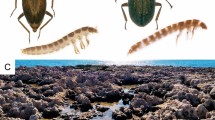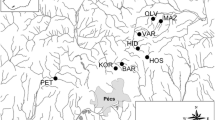Abstract
The regional dynamics of Daphnia longispina, D. magna and D. pulex living in rock pools was studied over a period of 17 years in 507 pools. Rock pools and their catchment areas were characterized by 12 habitat variables. Stepwise discriminant analysis was carried out using as the grouping variable the species with longest occupancy. The species habitat preferences differed significantly. D. magna preferred rock pools with higher conductivity, higher calcium content and higher pH, whereas D. pulex tolerated water with low conductivity, low pH and high humic content. D. longispina occupied larger and more sheltered rock pools with low conductivity and high pH. However, the canonical scores of species groups overlapped widely and scores of unoccupied rock pools did not differ from those of occupied pools. The length of occupancy was analysed with multiple regression analysis using discriminant scores and with species-specific occupancy times as dependent variables. In both D. longispina and D. magna, long patch occupancy was associated with greater pool size, greater height above the sea and a less exposed position. Rock pools inhabited by D. pulex were smaller. Also, the sheltered position of pools and the low calcium content characterized rock pools with long-lived populations of this species. In spite of habitat segregation, all three species show metapopulation dynamics with frequent extinctions and recolonizations at approximate equilibrium.


Similar content being viewed by others
References
Bengtsson, J., 1986. Life histories and interspecific competition between three Daphnia species in rockpools. Journal of Animal Ecology 55: 641–655.
Bengtsson, J., 1988. Life histories, interspecific competition and regional distribution of three rockpool Daphnia species. PhD thesis, Uppsala University, Sweden.
Bengsson, J., 1993. Interspecific competition and determinants of extinction in experimental populations of three rockpool Daphnia species. Oikos 67: 451–464.
Begtsson, J. & D. Ebert, 1998. Distributions and impacts of microparasites on Daphnia in a rockpool metapopulation. Oecologia 115: 213–221.
Carvalho, C. R. & R. N. Hughes, 1983. The effect of food availability, female-culture density and photoperiod on ephippia production in Daphnia magna. Freshwater Biology 13: 37–46.
Ebert, D., J. W. Hottinger & V. I. Pajunen, 2001. Temporal and spatial dynamics of parasites in a Daphnia metapopulation: Which factors explain parasite richness? Ecology 82: 3417–3434.
Ebert, D., C. Haag, M. Kirkpatrick, M. Riek, J. W. Hottinger & V. I. Pajunen, 2002. A selective advantage to immigrant genes in a Daphnia metapopulation. Science 295: 485–488.
Ganning, B., 1971. Studies on chemical, physical and biological conditions in swedish rockpool ecosystems. Ophelia 9: 51–105.
Ghilarov, A. M., 1967. The zooplankton of arctic rockpools. Oikos 18: 82–95.
Graham, M. H., 2003. Confronting multicollinearity in ecological multiple regression. Ecology 84: 2809–2815.
Haag, C. R., M. Riek, J. W. Hottinger, V. I. Pajunen & D. Ebert, 2005. Genetic diversity and genetic differentiation in Daphnia metapopulations with subpopulations of known age. Genetics 170: 1809–1820.
Hanski, I., 1994. A practical model of metapopulation dynamics. Journal of Animal Ecology 63: 151–162.
Hanski, I. & O. E. Gaggiotti, (eds.), 2004. Ecology, Genetics and Evolution of Metapopulations. Elsevier Academic Press, Burlington.
Hanski, I. & E. Ranta, 1983. Coexistence in a patchy environment: Three species of Daphnia in rock pools. Journal of Animal Ecology 52: 263–279.
Herbert, D. P. N., 1982. Competition in zooplankton communities. Annales Zoologici Fennici 19: 349–356.
Hutchinson, G. E., 1951. Copepodology for the ornitologist. Ecology 32: 571–577.
Hutchinson, G. E., 1953. The concept of pattern in ecology. Proceedings of the National Academy of Sciences of Philadelphia 105: 1–13.
Lagerspetz, K., 1955. Physiological studies on the brackish water tolerance of some species of Daphnia. Archivum Societatis Vanamo 9(suppl.): 138–143.
Levander, K. M., 1900. Zur Kenntnis des Lebens in den stehenden Kleingewässern auf den Skäreninseln. Acta Societatis pro Fauna et Flora Fennica 18(6): 1–107.
Pajunen, V. I., 1986. Distributional dynamics of Daphnia species in a rock-pool environment. Annales Zoologici Fennici 23: 131–140.
Pajunen, V. I. & I. Pajunen, 2003. Long-term dynamics in rock pool Daphnia metapopulations. Ecography 26: 731–738.
Patton, J. & W. Reeder, 1956. New indicator for titration of calcium with (ethylenedinitrilo) tetraacetate. Analytical Chemistry 28: 1026–1028.
Ranta, E., 1979. Niche of Daphnia species in rock pools. Archiv für Hydrobiologie 87: 205–223.
Acknowledgements
We wish to thank Dieter Ebert and Christoph Haag as well as two anonymous referees for their valuable comments on the manuscript.
Author information
Authors and Affiliations
Corresponding author
Additional information
Handling editor: S. I. Dodson
Rights and permissions
About this article
Cite this article
Pajunen, V.I., Pajunen, I. Habitat characteristics contributing to local occupancy and habitat use in rock pool Daphnia metapopulations. Hydrobiologia 592, 291–302 (2007). https://doi.org/10.1007/s10750-007-0769-4
Received:
Revised:
Accepted:
Published:
Issue Date:
DOI: https://doi.org/10.1007/s10750-007-0769-4




